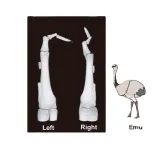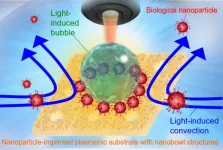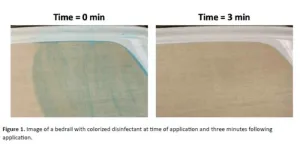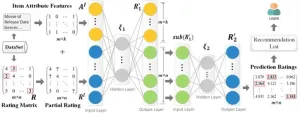(Press-News.org) Lavas from hotspots—whether erupting in Hawaii, Samoa or Iceland—likely originate from a worldwide, uniform reservoir in Earth’s mantle, according to an evaluation of volcanic hotspots published today in Nature Geoscience.
The findings indicate Earth’s mantle is far more chemically homogenous than scientists previously thought—and that lavas only acquire their unique chemical “flavours” enroute to the surface.
“The discovery literally turns our view of hotspot lavas and the mantle upside down,” said Dr. Matthijs Smit, associate professor and Canada Research Chair at the University of British Columbia’s Department of Earth, Ocean and Atmospheric Sciences. “In a way, Earth’s lavas are much like humankind itself—a beautifully diverse population with a common ancestor, which developed differently wherever it went.”
Research of Earth’s mantle has been complicated by the fact that it can’t be sampled directly. Scientists instead have to engage in a bit of geoscientific detective work; they study this important part of our planet through trace-element and isotope analysis of lava that comes from the mantle and is erupted at oceanic volcanoes around the world. The vast differences in composition of these lavas, along with the assumption that the isotope composition of magma doesn’t change between its source and the surface, has led to the general view that the mantle contains distinct reservoirs of different age, located in different regions, and formed by different processes. The observations made by Dr. Smit and co-author Dr. Kooijman of the Swedish Museum of Natural History’s Department of Geosciences indicate that the reality may be quite different.
“By looking at a specific set of elements, we were able discern the chemical effects of various processes that act on magma melts on their way to the surface to discover that all hotspot lavas actually share the same starting composition,” said Dr. Smit. “The lavas only come out differently because the magmas interact with different types of rocks as they ascend.”
Earth’s mantle is a seething layer of molten and semi-molten material comprising about 84 per cent of the planet’s volume, which lies between the iron core and the surface crust. When magma derived from the mantle penetrates the crust and erupts onto the surface it is called lava.
Knowing what the mantle is made of is central to our understanding of how our planet formed and how the mantle has developed over time. It may also provide clues as to why the mantle behaves the way it does, how it drives plate tectonics, and what its role is in the global cycle of elements.
Besides shedding entirely new light on hotspot lavas in oceanic parts of the world, the analysis also revealed an exciting new link to basaltic lavas on the continents. These melts, which contain diamond-bearing kimberlites, are fundamentally different from magmas found at oceanic hotspots. They nevertheless prove to have the same magma “ancestor”.
“The discovery is a game-changer when it comes to models for Earth’s chemical evolution and how we look at global element cycles,” said Dr. Smit. “Not only is the mantle much more homogeneous than previously thought, it likely also no longer contains “primordial reservoirs”—entities that were once needed to explain the data, but could never really be reconciled with the concept of mantle convection.”
“This model explains the observations in a simple way and permits a myriad of new hypotheses for global geochemical research going forward,” said Dr. Kooijman.
Financial support for this research was provided by the National Science and Engineering Research Council of Canada.
END
New research reenvisions Earth’s mantle as a relatively uniform reservoir
Earth’s mantle more chemically uniform than previously thought
2024-09-19
ELSE PRESS RELEASES FROM THIS DATE:
Global warming leads to drier and hotter Amazon: reducing uncertainty in future rainforest carbon loss
2024-09-19
The Amazon, often called the "lungs of the planet", is the world’s largest tropical forest, playing a crucial role in the global climate system due to its vast carbon storage. While it is typically warm and humid all year round, continued climate change poses the threat of more frequent and severe droughts and heat extremes. A new study, published in Nature Communications delves into future projections of the Amazon carbon cycle, focusing specifically on the impacts driven by climate change.
Scientists use the latest generation of Earth system models from the Coupled Model Intercomparison Project which contributed to ...
Low-carbon ammonia offers green alternative for agriculture and hydrogen transport
2024-09-19
A new way of making ammonia by harnessing the unique power of liquid metal could lead to significant cuts in carbon emissions caused by production of the widely-used chemical.
Ammonia is used in fertiliser to grow much of our food, but also plays a role in clean energy as a carrier to safely transport hydrogen.
The global production of ammonia, however, comes at a high environmental cost: it consumes over 2% of global energy and produces up to 2% of global carbon emissions.
RMIT Research Fellow and study ...
New mechanism uncovered for the reduction of emu wings
2024-09-19
Researchers have uncovered a fascinating mechanism behind the reduction and asymmetry of emu wing bones. The wings not only show significant shortening, but the skeletal elements also fuse asymmetrically, a phenomenon traced back to the absence of muscle formation in the distal regions of the wings. During development, this lack of muscle leads to insufficient mechanical stress, which is crucial for proper bone formation. The team identified muscle progenitor cells with a unique dual identity, combining characteristics of both somite1-derived myogenic and lateral plate mesoderm2 cells. These ...
Zeroing in on the genes that snakes use to produce venom
2024-09-19
Only about ten percent of the world’s roughly 4,000 snake species have venom strong enough to seriously hurt a human, but that’s enough for snake bites to be an important public health concern. To help better understand how snakes make their venom and how venoms differ from one species to another, researchers developed a new way to zero in on the genes that snakes use in venom production. Their work was published in the journal Molecular Ecology Resources.
“We’ve developed a tool that can tell us which venom-producing genes are present across an entire snake family in one fell swoop,” says Sara Ruane, the Assistant Curator of Herpetology in the ...
Maynooth University study reveals impact of homework on student achievement in maths and science
2024-09-19
· Daily homework of up to 15 minutes most effective for maths achievement
· Homework assigned three to four times a week benefits science performance
· Short duration homework just as effective as longer assignments
Researchers at Maynooth University’s Hamilton Institute and Department of Mathematics and Statistics in Ireland have unveiled significant findings on the role of homework in student achievement. The research, led by Prof Andrew Parnell, Nathan McJames and Prof Ann O’Shea, used a new AI model to analyse data from the Trends in International Mathematics and Science ...
Reducing floodplain development doesn’t need to be complex
2024-09-19
A new paper in Oxford Open Climate Change, published by Oxford University Press, uncovers evidence suggesting that, contrary to expectations, most U.S. cities are not doing too badly in avoiding development in areas prone to flooding, and those that are effective appear to be applying existing tools and strategies well, rather than doing anything particularly novel.
Despite billions of dollars of investments and widespread mitigation efforts, the costs of disasters in the United States have grown dramatically. ...
Lights, camera, action! Coronavirus spike proteins can be selectively detected in 5 minutes
2024-09-19
Like moths to a flame, microbes can also be moved by light. Using this knowledge, researchers from Osaka Metropolitan University’s Research Institute for Light-induced Acceleration System (RILACS) have demonstrated a method to detect the presence of viruses quickly and using only a small sample.
The research team led by OMU Professor Takuya Iida, the director of RILACS, and Associate Professor Shiho Tokonami, the deputy director, report in npj Biosensing on a light-induced immunoassay. Using ...
Your Zoom background could influence how tired you feel after a video call
2024-09-19
Part of many people’s pandemic experience included working from home. Even after lockdowns, videoconferencing remains a big part of life as people continue to work remotely, connect with families and friends online, and attend virtual events hosted on videoconferencing platforms.
Spending hours on video calls, however, can be exhausting and manifest as physical, emotional, or cognitive tiredness – a phenomenon known as videoconferencing fatigue (VF). Now, researchers in Singapore have asked if a relationship between virtual backgrounds and VF exists and ...
With the use of visual cues, hospital rooms get nearly 70% cleaner
2024-09-19
With the Use of Visual Cues, Hospital Rooms Get Nearly 70% Cleaner
New study shows that a simple color additive in disinfectant wipes dramatically improved room cleanliness and even reduced time needed for cleaning
Arlington, Va. — September 19, 2024 — A new study published today in the American Journal of Infection Control (AJIC) reports a comparison of hospital room cleanliness using standard disinfectant wipes versus wipes with a color additive that allows users to see which surfaces have been sanitized. With the color additive, rooms ...
Serial-autoencoder for personalized recommendation
2024-09-19
In the last decade, auxiliary information has been widely used to address data sparsity. Due to the advantages of feature extraction and the no-label requirement, autoencoder-based methods addressing auxiliary information have become quite popular. However, most existing autoencoder-based methods discard the reconstruction of auxiliary information, which poses a huge challenge for better representation learning and model scalability.
To solve the problems, a research team led by Zhu YI published their new research on 15 August 2024 in Frontiers of Computer Science co-published by Higher Education Press and Springer Nature.
The team proposed a novel representation ...
LAST 30 PRESS RELEASES:
Interaction of climate change and human activity and its impact on plant diversity in Qinghai-Tibet plateau
From addressing uncertainty to national strategy: an interpretation of Professor Lim Siong Guan’s views
Clinical trials on AI language model use in digestive healthcare
Scientists improve robotic visual–inertial trajectory localization accuracy using cross-modal interaction and selection techniques
Correlation between cancer cachexia and immune-related adverse events in HCC
Human adipose tissue: a new source for functional organoids
Metro lines double as freight highways during off-peak hours, Beijing study shows
Biomedical functions and applications of nanomaterials in tumor diagnosis and treatment: perspectives from ophthalmic oncology
3D imaging unveils how passivation improves perovskite solar cell performance
Enriching framework Al sites in 8-membered rings of Cu-SSZ-39 zeolite to enhance low-temperature ammonia selective catalytic reduction performance
AI-powered RNA drug development: a new frontier in therapeutics
Decoupling the HOR enhancement on PtRu: Dynamically matching interfacial water to reaction coordinates
Sulfur isn’t poisonous when it synergistically acts with phosphine in olefins hydroformylation
URI researchers uncover molecular mechanisms behind speciation in corals
Chitin based carbon aerogel offers a cleaner way to store thermal energy
Tracing hidden sources of nitrate pollution in rapidly changing rural urban landscapes
Viruses on plastic pollution may quietly accelerate the spread of antibiotic resistance
Three UH Rainbow Babies & Children’s faculty elected to prestigious American Pediatric Society
Tunnel resilience models unveiled to aid post-earthquake recovery
Satellite communication systems: the future of 5G/6G connectivity
Space computing power networks: a new frontier for satellite technologies
Experiments advance potential of protein that makes hydrogen sulfide as a therapeutic target for Alzheimer’s disease
Examining private equity’s role in fertility care
Current Molecular Pharmacology achieves a landmark: real-time CiteScore advances to 7.2
Skeletal muscle epigenetic clocks developed using postmortem tissue from an Asian population
Estimating unemployment rates with social media data
Climate policies can backfire by eroding “green” values, study finds
Too much screen time too soon? A*STAR study links infant screen exposure to brain changes and teen anxiety
Global psychiatry mourns Professor Dan Stein, visionary who transformed mental health science across Africa and beyond
KIST develops eco-friendly palladium recovery technology to safeguard resource security
[Press-News.org] New research reenvisions Earth’s mantle as a relatively uniform reservoirEarth’s mantle more chemically uniform than previously thought






